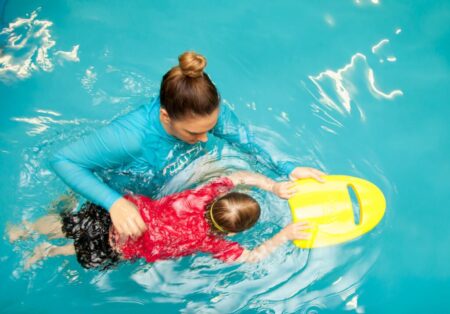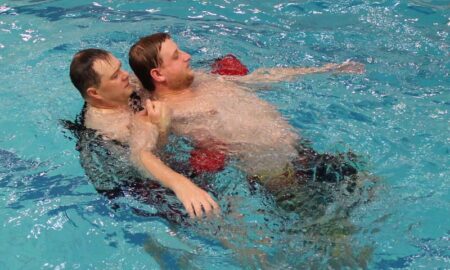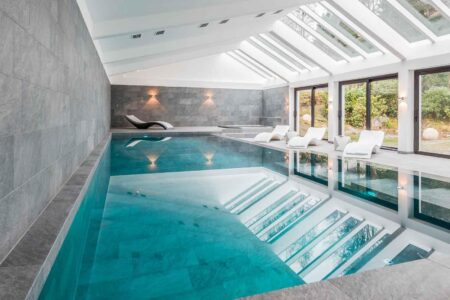How Do Baby Swim Lessons Differ Across Countries and Cultures?
Ever wonder how babies in China or Sweden learn to swim? All over the world, parents want the best outcome for their children, and that‚Äôs why they look to baby swim classes to instill this critical skill. In every culture, babies learn to splash, float, and keep their heads above water‚ÄĒ but the how, when, and where can look surprisingly different!
Baby Swim Lessons in Sweden

In Sweden, babies often begin baby swim classes (known as ‚Äúbabysim‚ÄĚ) remarkably early‚ÄĒ sometimes as young as 4 weeks old, though typically between 3-12 months. This early introduction to water is deeply embedded in Swedish culture.
The Swedish approach prioritizes:
Playful familiarization: Rather than formal swimming techniques, Swedish baby swim classes focus on making water a positive, enjoyable environment through games and gentle exercises
Parental participation: Parents join babies in the water, creating bonding opportunities while providing security
Developmental benefits: Swedish research emphasizes how early swimming stimulates social, sensory, and motor skills development
Gradual progression: Lessons typically involve three sub-courses that slowly increase in complexity as babies develop
Swedish instructors often incorporate songs and games, making the learning process fun and natural. This aligns with broader Swedish cultural values around outdoor activity and connection with nature.
Swimming Lessons for Babies in India
In India, baby swim lessons combine traditional practices with modern teaching methodologies, typically beginning around 6 months.
The Indian approach to baby swimming emphasizes:
Gradual familiarization: Programs begin with basic water comfort activities before introducing more structured skills.
Building block methodology: Skills are taught sequentially, with each new ability building upon previously mastered techniques.
Parental participation: Similar to other cultures, parents play an essential role in the learning process, providing physical and emotional support.
Safety education: Parents receive comprehensive training on water hazards and emergency responses alongside their children’s lessons.
Holistic benefits: Beyond safety, Indian swimming programs often highlight improved sleep, appetite, and confidence as key benefits.
Technique progression: As children develop confidence, they gradually transition to learning formal swim strokes around age 5-6.
Specialized methodologies: Some programs incorporate techniques like ‚Äúswim, float, swim‚ÄĚ that teach children to alternate between swimming and floating for rest.
The Indian approach reflects the country’s growing emphasis on early childhood development while acknowledging the importance of water safety in a nation with diverse aquatic environments from coastal areas to rivers.
Baby Swim Classes in Australia

Australia‚Äôs relationship with water runs deep‚ÄĒ with miles of coastline and a strong swimming culture, Australians prioritize water safety from an early age.
Key elements of Australian baby swimming classes include:
Early introduction: Baby swim lessons often begin between 3-6 months
Safety emphasis: Given Australia’s high drowning rates, these early programs focus heavily on water safety skills
Parent-guided learning: Parents participate actively in the water with their babies
Progression to formal lessons: While Royal Life Saving Australia recommends formal swimming lessons starting at age 4, these baby classes create foundational comfort with water
Australia’s approach reflects its unique environment, where beach and pool safety is considered an essential life skill rather than just recreation.
Swim Lessons in The Netherlands
In the Netherlands, where canals and waterways are prevalent throughout the country, swimming is considered a critical survival skill. Their ‚ÄėSwim ABC‚Äô program reflects their practical approach. The Dutch system features:
National standardization: The ‚ÄúSwim ABC‚ÄĚ program provides consistent teaching methods nationwide
Survival prioritization: Children learn to turn from front to back, float, and navigate to safety
Diploma progression: Students work toward three national swimming diplomas (A, B, and C)
Comprehensive water safety: The program goes beyond just swimming strokes to include skills like swimming in clothes.
The Dutch approach acknowledges that accidents happen, and children need practical skills to save themselves if they unexpectedly fall into water‚ÄĒ a reflection of the country‚Äôs geography and cultural emphasis on preparation.
Baby Swim Classes in Russia
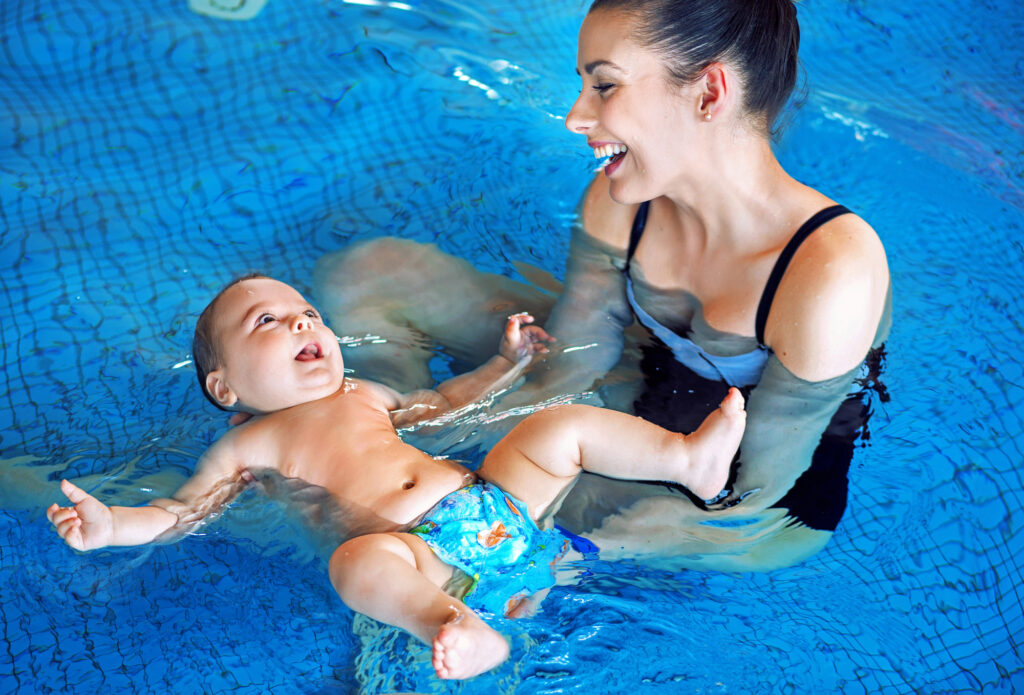
Did you know Russian babies begin their swim journey when they are tiny? At just two months old, these water babies are making surprising splashes!Russian swimming teachers have an amazing trick up their sleeves: they work with babies‚Äô natural ‚Äúdiving reflex‚ÄĚ ‚Äď that cool instinct that makes babies automatically hold their breath underwater. (Yes, it‚Äôs actually a thing babies are born knowing how to do!)Here‚Äôs what makes Russian baby swim lessons so fascinating:Beginning young: Babies start swimming at 2 months old.Baby swimming centers: These have popped up all over Russia to accommodate the demandBeyond certifications: Many instructors are celebrated athletes and coachesPart of the process: Parents are included in the techniques, which makes for extra special bonding time.Beyond survival skills: Swimming is treated as a way to help babies sleep better, grow stronger, and even relax.Russians believe babies are actually natural-born swimmers who just need a little help remembering what they already know. There‚Äôs something inspiring about their confidence in babies‚Äô natural abilities!
Swim Lessons in China

Baby swim lessons in China don‚Äôt always happen at the pool‚ÄĒ at least, not the kind we swim in. Because so many people live in densely populated urban settings where big pools are hard to come by (not to mention expensive!), creative solutions have emerged.Chinese baby swimming practices often include:
Specialized equipment: Individual tubs rather than pools, with special neck flotation devices
Comprehensive care: Sessions typically include pre-swim massage, the swim itself, and post-swim bathing
The first time you see a baby happily floating in what looks like a fancy kitchen sink, it might seem unusual! But this approach brilliantly solves the space problem while giving babies the freedom to kick and splash in their personal water space.
Baby Swim Classes at WeAquatics
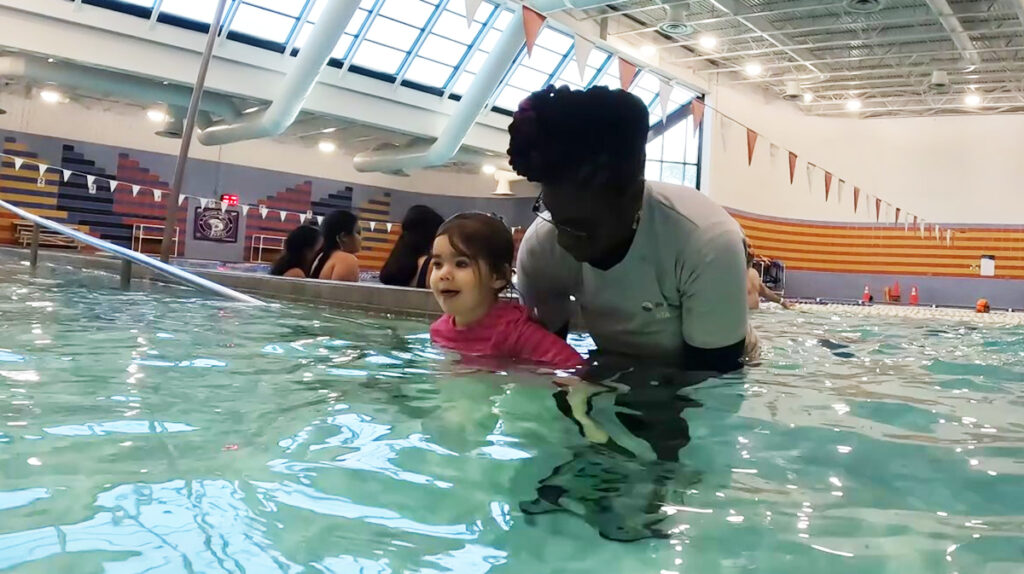
At WeAquatics, we embrace the Infant Swimming Resource‚ĄĘ (ISR) methodology, which incorporates the best elements from global practices while adding decades of research and refinement.The ISR approach we use features:
Science-backed techniques: Developed and refined over 40+ years of research
Age-appropriate skills: Customized approaches for different developmental stages
Safety prioritization: Teaching self-rescue skills that could save lives
Brief, effective sessions: 10-minute lessons that match young children’s attention spans
Progressive skill building: Building from basic floating to more advanced techniques
For babies 6-18 months, we focus on teaching babies to:
Roll onto their backs
Float and rest
Breathe and wait
 
Children aged 18 months+ learn the swim-float-swim sequence, allowing them to swim, roll on their back to breathe, and then resume face-down swimming to safety. 
What We Can Learn From Global Approaches
These diverse approaches to baby swimming reveal how cultural context shapes water education, but they also share common themes:
Early introduction to water is beneficial across cultures
Parental involvement enhances the learning experience
Safety skills are universally prioritized, though approached differently
Play and positive association with water matter everywhere
Progression and age-appropriate expectations are critical
 
Understanding these global perspectives enhances our approach. WeAquatics incorporates the practical safety focus on Australia, the systematic progression of the Netherlands, the early introduction of Sweden, the reflex awareness of Russia, and the individualized, one-on-one attention of China‚ÄĒ all while maintaining our commitment to the proven ISR methodology!Are you ready to begin your little one‚Äôs journey to aquatics survival skills? Connect with WeAquatics to learn more about our Infant Swimming Resource‚ĄĘ classes for babies and toddlers.


